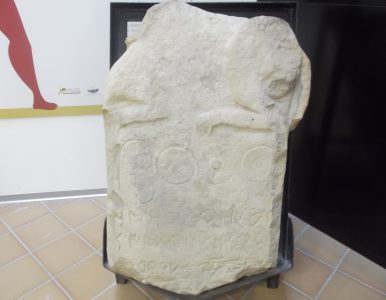- Una lectura de la piedra grabada del león del Acampador (Caspe)
Esta piedra grabada del león del Acampador de Caspe, datada entre los siglos III y II a. C, es una pieza muy interesante para el estudio histórico y lingüístico de la zona del Bajo Aragón en época Ibérico Final. Es preciso contextualizarla dentro de los acontecimientos bélicos de esa época en dicho lugar.
El texto de esta piedra, aunque incompleto, escrito en epigrafía ibérica se transcribe así:
Osortarbanenzildar: iariber*arireboretar… …
El análisis lingüístico basado en la lengua vasca nos permite hacer una lectura coherente del texto dentro de su contexto histórico y arqueológico:
La lectura del primer segmento, Osortar, abre el camino para encontrar iber*ar y boretar, de tal modo que permite identificar gentilicios (en euskara, el sufijo –(t)ar) que podrían corresponderse a tres de los escudos guerreros representados en la piedra.
El estudio histórico y lingüístico que se presenta propone que la piedra representa un acuerdo entre varios linajes del territorio del Bajo Aragón para hacer frente a otros ejércitos.
- A reading of the engraved stone of the Acampador’s lion (Caspe)
This engraved stone of the Acampador’s lion in Caspe, dated between the 3rd and 2nd centuries BC. is a very interesting piece for the historical and linguistic study of the Lower Aragón area in the Final Iberian period. It must be contextualized within the warlike events of that time in that place.
The text of this stone, although incomplete, written in Iberian epigraphy is transcribed as follows:
Os ̇ortar ̇banenzildar: iariber ̇ * arir ̇eboretar……
Linguistic analysis based on the Basque language allows us to make a coherent reading of the text within its historical and archaeological context:
Reading the first segment, Os ̇ortar ̇, opens the way to find iber ̇ * ar and boretar, in such a way that it allows identifying gentile names (in Basque, the suffix – (t) ar) that could correspond to three of the warrior shields represented in the stone.
The historical and linguistic study that is presented proposes that the stone represents an agreement between various lineages of the territory of Lower Aragon to face other armies.
- Caspeko El Acampadorreko lehoiaren harria: iberiar epigrafian idatzitakoa irakurtzen.
Caspeko El Acampadorreko lehoiaren harri honek testua dauka idatzita iberiar epigrafian. K. a. III. eta II. mendeen artekoa izanik, oso pieza garrantzitsua da aro horretako Behe Aragoiko ikerketa historikoa eta linguistikoa egiteko. Bere tokian eta bere denboran aztertu behar da harri hau, orduko gerra-istiluen testuinguruan, hain zuzen ere.
Osorik ez badago ere, honelaxe dago testua transkribatuta:
Osortarbanenzildar: iariber*arireboretar… …
Euskaran oinarritutako hizkuntza-azterketak testua bere testuinguru historiko eta arkeologikoan koherentziaz interpretatzeko bideak zabaltzen ditu:
Lehen segmentuan bertan, Osortar moduan irakurritakoan, irekitzen da atea jarraian datozen iber*ar eta boretar irakurtzeko (euskarazko –(t)ar atzizkiaren lorratzean). Bestalde, datu historikoen arabera, batetik, eta hizkuntzaren azterketaren arabera, bestetik, hauxe interpreta daiteke: harrian grabatuta dauden hiru armarriei hiru familia-izen horiek dagozkiela ulertuta, familia horien arteko itun edo akordio garrantzitsuren baten oroigarria dela El Acampadorreko harria.
DESCARGAR DOCUMENTO (PDF)

